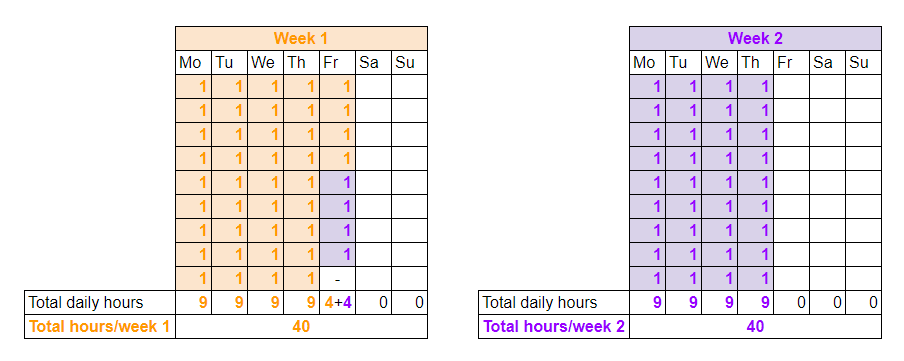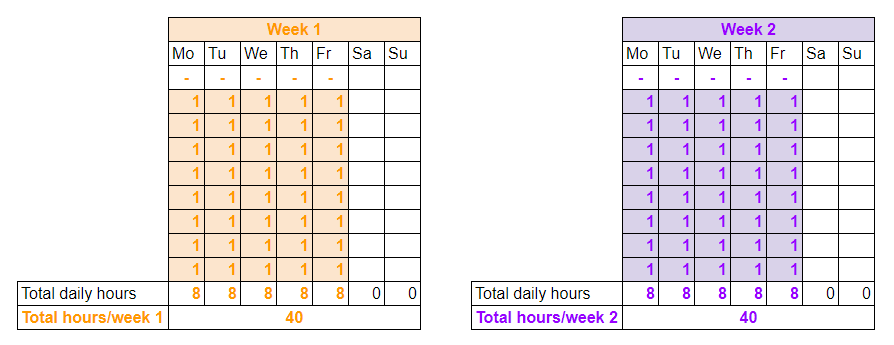What is a 9/80 work schedule?
9/80 is a working arrangement that involves grouping the work schedule to obtain an extended weekend (Fr + Sa + Su) every two weeks.
Of course, in terms of its application in a company with employees, this must be done in accordance with the FLSA (Fair Labor Standards Act). Therefore, it may not be applicable in all areas of activity.
But if you are a freelancer or self-employed and if you want to have more time to enjoy life, you will likely find this method of grouping your working hours to be really interesting.
In this article, you will find all the details you need to know to decide if the 9/80 schedule is suitable for your business.
Why is it called the 9/80 work schedule?
We are used to expressions that clearly indicate what they represent, like:
- 24/7 which means 24 hours a day, 7 days a week
- 40/week, which means 40 hours of work per week
- 8 hours/day, which means the working day has 8 hours
But 9/80, 9-80, or just plain and simple 9 80, doesn’t seem to say anything specific. That’s because we’re used to talking about a work interval in terms of a day, a week, or a month.
Normally, on a schedule of 8 hours a day, 5 days a week, we work 40 hours a week. This means that in two weeks, we work 10 days or 80 hours.
But things are a little different with this specific working schedule.
An extended weekend every second week means that every second Friday is free. Therefore, the 80 hours have to be completed in 9 days
Hence, the 9/80 work schedule refers to the 80 hours worked in 9 days.
What is the 9/80 workweek?
As we saw above, there are some differences in the distribution of working hours compared to a “normal” working week. Those differences make it possible to work 80 hours in just 9 days and not in 10 days.
According to FLSA, the minimum hours to be worked for the minimum wage are 40 per week. Also, we must take into account the fact that the working week means exactly 7 consecutive 24-hour periods (168 hours). It is also very important to remember that each workweek stands alone and there can be no averaging of two or more workweeks.
Therefore, the way the working hours are distributed in 9/80 schedules involves the following:
In Week 1
From Monday to Thursday inclusive, we will work 9 hours every day. That means 4 days multiplied by 9 hours each, which is 36 hours.
We still have 4 hours to complete up to the minimum of 40. Therefore, we will perform these in the first part of Friday.
- Monday = 9 hours
- Tuesday = 9 hours
- Wednesday = 9 hours
- Thursday = 9 hours
- Friday = 8 hours, 4 hours from Week 1 PLUS 4 hours for Week 2
- Saturday = free
- Sunday = free
In Week 2
Similar to Week 1, we will work 9 hours every day from Monday to Thursday inclusive. That is also 36 hours.
After that, we still have 4 hours to complete up to the minimum of 40, but Friday is free. Therefore, these hours were included on Friday of Week 1.
- Monday = 9 hours
- Tuesday = 9 hours
- Wednesday = 9 hours
- Thursday = 9 hours
- Friday = free
- Saturday = free
- Sunday = free
Friday of Week 1
On this day, we work 8 hours. Of these, 4 hours are part of Week 1 and the other 4 are part of Week 2.
Friday of Week 2
It’s FREE! Time for us to enjoy the extended weekend.
This way of distributing and framing the hours on working days offers the possibility of having an extended weekend in Week 2, in compliance with the legislation.
What does a 9/80 schedule look like?
We’ve all heard “A picture is worth a thousand words.” In this case, an image is a perfect choice for explaining the schedule. This is what the two working weeks in which we apply the 9/80 work schedule look like.
In this situation:
- In the first week, from Monday to Thursday we work 9 hours a day, while on Friday we work only 8 hours, of which 4 are part of the first week and 4 are part of the next. The weekend is normal, made up of Saturday and Sunday.
- The next week, we work from Monday to Thursday for 9 hours a day, while Friday is free. This means that we have an extended weekend made up of Friday, Saturday, and Sunday.
To make it easy to see the difference, here are what the usual two working weeks look like, i.e., the ones with the 8-hour/day, 5-day/week schedule.
Does 9/80 include lunch?
FLSA rules also provide guidance on short breaks and lunch breaks. Therefore, they will also apply to 9/80 programs. This means that rest times of 20 minutes or less will be compensated for. However, lunch breaks are time intervals that do not have to be paid as hours worked, provided that the employee is completely relieved of duty during these 30 or 60 minutes.
Is a 9/80 work schedule right for your business?
It probably sounds good to have an extended weekend every other week. However, this activity planning model is not suitable for every field of activity.
Those who find it easier to adopt such a flexible schedule are those who have businesses in areas such as management, information, professional, business, and financial services, or those who work as managers, executives, administrators, salespeople, and office workers.
At the opposite pole are those who work as firefighters, nurses, manufacturers, teachers, or police, or who carry out their activities in fields such as construction, transportation, maintenance, and production.
In addition to the field of activity that your business is part of, you must consider other factors when you are deciding whether to implement the 9/80 schedule in your business.
Consider the impact on customers
For example, this schedule might affect your customers. Depending on your field of activity, this could be decisive in adopting, or not, such a compressed work arrangement.
Is 9 working hours per day appropriate for your business?
If your business requires intense physical effort, it may be too difficult to sustain this for 9 hours a day. In fact, for activities that involve intense socialization with customers, such a program may not be appropriate.
Consider the legal terms
In some states, the terms of overtime are established rules not only for the 40 hours per week but also for the number of hours worked per day.
The 9/80 schedule requires 9 hours of work per day. If the law in the state where you work says that you must be paid overtime for anything exceeding 8 hours of work per day, this work schedule is not right for your business.
Sick time and holidays
The fact that you work a different number of hours on certain days (sometimes 9, sometimes 8) will also influence how employees benefit from holidays and sick time.
- Sick time – the deduction from their sick leave reserve will also be 9 hours;
- Holidays – an additional 1-hour credit of personal time off (PTO) will be added to the 8-hour holiday credit.
How to adopt a 9/80 schedule in your business

The adoption of a 9/80 schedule should be done in steps to ensure its success.
Of course, if you are a freelancer or self-employed, it is easy to decide what to do. However, if you have employees, you will need to implement the changes gradually so that they do not cause any inconvenience.
Consult with employees
If your business has several employees, one of your first steps will be to talk to them. Some employees might have to travel to get to work. Thus, if the 9 hours worked daily are added to the lunch break, and on top of that the employee has a 1-hour commute, the effort might be too big to compensate for an extended weekend.
Share your reasons for implementing this schedule
From the start, make it clear exactly what you would like to achieve. People tend to resist things they don’t understand. Therefore, if everyone knows and understands exactly what the change is about, you will benefit from their full collaboration.
Test the method on a control group
If everything seems ok so far, it would be advisable to implement the schedule on a control group in the first phase.
This means that, for a period of time, only a small number of employees use this program. This will allow you to determine exactly what works and what doesn’t, without affecting the whole company’s process.
Make all the necessary changes
You will need to implement the exact parameters for which the 9/80 schedule will apply. Also, clear guidelines will need to be established for everyone.
Keep in mind that this method may affect the way that time off, overtime, or medical leave is calculated, and all of these changes will need to be implemented in compliance with the law. Therefore, the analysis and processing of data in the HR and payroll department are of paramount importance in this type of change.
Track the time
Once you implement the system, you will have to engage in rigorous planning and carefully track the time, whether you are the only one working in your business or you have employees. This is the only way to determine the results. To eliminate flaws and make the most of this schedule, it is recommended that each person should know exactly what he or she did during each of the hours worked.
Fill in the timesheets daily
Daily completion of the timesheet is very important to ensure the correctness of all data entered. This way, you can avoid problems of any kind, in terms of both an 8- or 9-hour workday or normal hours with overtime, and anything else about the work schedule. All this can be done very simply with an Easy-to-Use Free Online Time Card & Timesheet Calculator
A 9/80 schedule with a 24/7 business
If your business requires a 24/7 schedule, it will be a little tricky to implement the 9/80 work schedule, but it is certainly possible. We will show you a possible planning model.
To create this schedule, we take into account the 3 shifts, namely, morning, day, and night.
Due to the 9 hours of work on a shift, the working hours between shifts will overlap. That’s because we have 24 hours to cover, and the 3 shifts of 9 hours each equate to 27 hours.
For this reason, at each shift change, there will be an overlap of 1 hour between the two shifts as follows:
- Shift 1, morning shift 06:00 +9h 15:00. It will overlap with
- Shift 1 in the interval 06:00 – 07:00
- Shift 2 in the interval 14:00 – 15:00
- Shift 2, day shift 14:00 +9h 23:00. It will overlap with
- Shift 1 in the interval 14:00 – 15:00
- Shift 3 in the interval 22:00 – 23:00
- Shift 3, night shift 22:00 +9h 07:00 It will overlap with
- Shift 2 in the interval 22:00 – 23:00
- Shift 1 in the interval 06:00 – 07:00
If we take into account the two weeks in which 80 hours are completed, we must also keep in mind that we will need more employees to complete the shifts. Also, on some working days, the shifts will overlap.
Here’s what a 9/80 schedule might look like on a 24/7 basis:

Of course, there are several possibilities to do a two-week rotation in this type of schedule. This is just one of the options.
Just as important is the fact that, depending on the situation, you will have to consider the number of hours worked per week.
In the example presented, employees will work 80 hours in 9 days. But:
- for Employee 1, Week 1 has only 36 hours, while Week 2 has 44 hours worked;
- and for Employee 2, Week 1 has only 35 hours, while Week 2 has 45 hours worked
In some situations, this could cause problems because, in Week 2, the 40 hours provided by FLSA are exceeded and, therefore, should be paid as overtime.
Pros and cons of the 9/80 work schedule
There are many points of view from which we can look at this work arrangement. Each of them has its pros and cons, including the following.
Regarding employees
Pro: The most significant benefit of this way of planning working hours is that it promotes the well-being of employees. This will lead to a multitude of benefits for your business, as employees will most likely be more
- motivated to work and meet their targets
- productive because they are happier
- relaxed because they will have one less day of commuting
- more satisfied because they will spend less on transportation
Employees’ moods are clearly reflected in the results of their work.
Con: Depending on the field of activity, 9 hours of work per day may be too much. A person’s attention has its limits, and at the end of a 9-hour day, employees might not be as productive as they were at first. The same can happen if the work requires a sustained physical effort.
Regarding resource management
Pro: In certain situations, you can reduce costs, especially if you provide transportation for employees or daycare for their children.
Cons: You might not have enough employees to implement this system. This is especially true if you want to keep the business open on weekends or at least on Fridays.
Regarding customers
Pro: Employee satisfaction will be reflected in the way they interact with customers—and we all know what a big impact customer satisfaction has on business.
Con: A free Friday may not match your clients’ plans. If that’s when they need you, they certainly won’t be happy about waiting until Monday.
Is a 9/80 schedule worth it?
This depends on several factors and can vary from business to business. One basic thing to consider is that while employees want a flexible schedule, customers want 24/7 services. For this reason, the implementation of a compressed work schedule can be quite challenging for many businesses.
To determine whether or not it will work, we need to balance both the negative and positive effects. Therefore, we must consider the following:
- Whether it is legal to work more than 8 hours a day (considered normal work hours, not overtime) in the state where your business operates.
- Whether the costs involved in paying overtime (if applicable) are higher or lower compared to the financial benefits of this change of schedule.
- Whether employee productivity decreases too much or remains at a satisfactory level during all working hours (which may differ depending on your business’s activities).
- How your customers perceive the three days off (if applicable).
- Whether it is possible to provide all the necessary staff and to alternate work schedules so that you can cover all the hours when you want to keep the business open.
- Whether some employees can continue working 9-5, while others adopt the new 9/80 schedule.
If all these points can be resolved, 9/80 might be the perfect program for your business.
Potential pitfalls
From what we’ve seen so far, everything seems ok. However, if that’s the case, why hasn’t the classic 9-5 been replaced by the new 9/80 on a larger scale? Certainly, some aspects of 9/80 are less favorable. Among them are the following:
- In some situations, the 9 hours of work per day don’t leave us with much time or energy.
- Requests for days off may be a little more complicated to resolve, considering that some working days have 9 hours and others 8.
- You may need more employees, especially in a 24/7 business.
- You might have problems with overtime, especially if you are in a state where the law states that everything over 8 hours a day is paid as overtime.
- Incompatibilities can arise with the work schedules of companies you do business with.
What is the benefit of working a 9/80 schedule?
In this regard, it is useful to present the situation from both the employee’s point of view and the employer’s point of view.
For employees
- Several consecutive days to spend on personal activities. We all must maintain a good balance between professional and personal activity. While, in the case of this scheduled time, we will have 1 less personal hour on a daily basis, we can recover on the extended weekend.
- The possibility to focus more on what you have to do when you are at work and to finish your projects on time. In this regard, we earn an hour a day, which will positively influence our productivity. Having more time available will also allow us to focus better.
- A 1-day reduction in our commute. Some people’s commutes last 2 hours, so they will likely enjoy having 1 fewer day to spend in traffic to and from work.
- Reduced expenses for childcare and transportation. Having two extra days a month on which we don’t have to cover these costs will definitely add up over the course of a year.
For the employer
- More dedicated employees. As long as their rights are respected and they have the opportunity to spend even more time with their loved ones, there will be no reason for your employees to want to change jobs. Plus, in some situations, people prefer the comfort of a more flexible program to a few extra cents.
- Reduced absenteeism and tardiness. After an extended weekend, there will be fewer situations in which someone is late on Monday morning or does not show up for work without a good reason.
- More opportunities to create a flexible schedule that makes employees happy. This way, you can cover all the hours you want your business to be open, and your customers will be delighted by the way your satisfied employees treat them.
- Increased efficiency in completing tasks and respecting deadlines for projects. Although it doesn’t seem like much, an extra hour counts. Productivity might drop a little in that last hour, but that isn’t necessarily a bad thing. During that time, a series of activities can be included to ensure a strong start the next morning.
Another type of compressed work arrangement
The 9-80 work schedule is not the only option for changing the working day from 5 days a week to 4 days a week. Some companies have adopted the 4/40 work schedule.
In this schedule, the 40 hours of work per week are fulfilled in just 4 days. Therefore, every working day has 10 hours and every Friday is free. It follows that every weekend includes Fridays, Saturdays, and Sundays.
This schedule is also known as the 4/10 schedule, which means 4 days of 10 hours each.
A 2019 survey showed that 32% of US employers offer this type of compressed work arrangement to their employees. The flexibility of this schedule is all the greater, as employers can continue to keep their businesses open in the form of a normal workweek throughout the year.
However, this type of compressed workweek also requires that several conditions be met simultaneously, and quite a few companies may not be able to comply with them.








